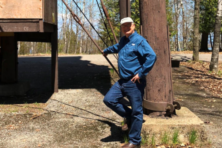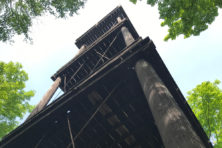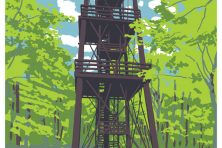Concept Plans Ordered for Potawatomi Tower
- Share
- Tweet
- Pin
- Share
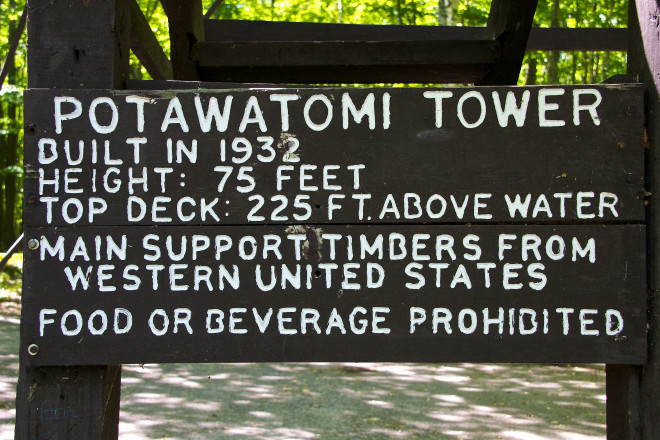
Decisions coming after November election
The latest action on the Potawatomi State Park Observation Tower announced Tuesday by Gov. Tony Evers’ office was received skeptically by those who suspect another planned delay in a project that has already been stalled to the detriment of the ailing tower – and this time safely past the hump of the legislative and gubernatorial elections in November.
“They’re letting it rot in the woods while they study it to death,” said Christie Weber with the Sturgeon Bay Historical Society Foundation (SBHSF), the organization that has led the push to save the structure.
“It’s nothing more than an attempt to delay the restoration of the tower to the point where it can no longer be restored,” said Dave Allen, founder of the Potawatomi Park Alliance, an organization he formed earlier this year.
The action announced was a request for professional architectural and engineering design services to provide the Wisconsin Department of Natural Resources (DNR) with construction administration services for the revitalization of the tower.
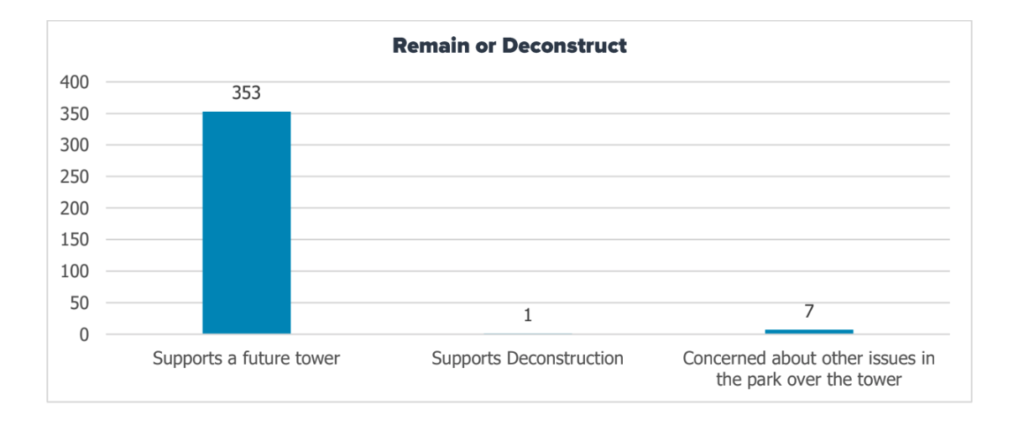
With a project budget of $25,000, the pre-design services would include the development of two 10% concept plans, with detailed cost estimates for both. The first concept must review the existing tower conditions and provide a concept plan for the historical restoration of the tower. The second would provide a concept plan for a tower that’s constructed with new materials that reflect the historical character of the current tower.
With both concept plans, the tower must be fully accessible at all observation levels to all park visitors, including individuals with physical disabilities, according to the request for proposals (RFP).
“It’s clear folks want to see a restored or reconstructed tower at Potawatomi State Park,” Evers said in the statement announcing the RFP. “We also recognize that accessibility is a critical consideration for any building project, especially one as cherished as the Potawatomi tower.”
DNR Secretary Preston Cole linked the positive reception of the new Eagle Tower accessibility in Peninsula State Park with a need to make Potawatomi Tower accessible to all.
“The comments we received and the overwhelmingly positive public response to the fully accessible Eagle Tower at nearby Peninsula State Park drive home the importance of improving access to our outdoors,” Cole said in a statement. “We look forward to building on that important work at Potawatomi.”
The state’s request for the RFP follows a public-comment period that the DNR held earlier this year on what people wanted to see happen with the tower. A total of 361 people submitted comments online, via email or during a Feb. 22 Zoom meeting. An overwhelming majority of people were in favor of saving the tower, according to the feedback summary the DNR provided.
“It was crucial for us to hear from the public regarding the future of the Potawatomi Observation Tower, and we thank everyone who took the time to weigh in,” Cole said in a statement. “The department recognizes the tower’s importance to Potawatomi State Park visitors and the surrounding community.”
Advocates for the tower’s repair have argued all along that maintenance repairs done on the historical structure do not trigger ADA (Americans with Disabilities Act) requirements. They also say that access to the views provided by the tower for those who can’t climb it could be addressed separately.
“The vast majority of citizens who weighed in on this issue during the DNR’s call-in event and through Survey Monkey want the current tower restored,” Allen said. “Even those who acknowledged the importance of accessibility also did not want accessibility to stand in the way of restoration.”
By the DNR’s own data from the comment period, only 50 of the 361 people who commented supported making the existing tower ADA accessible (see accompanying graph).
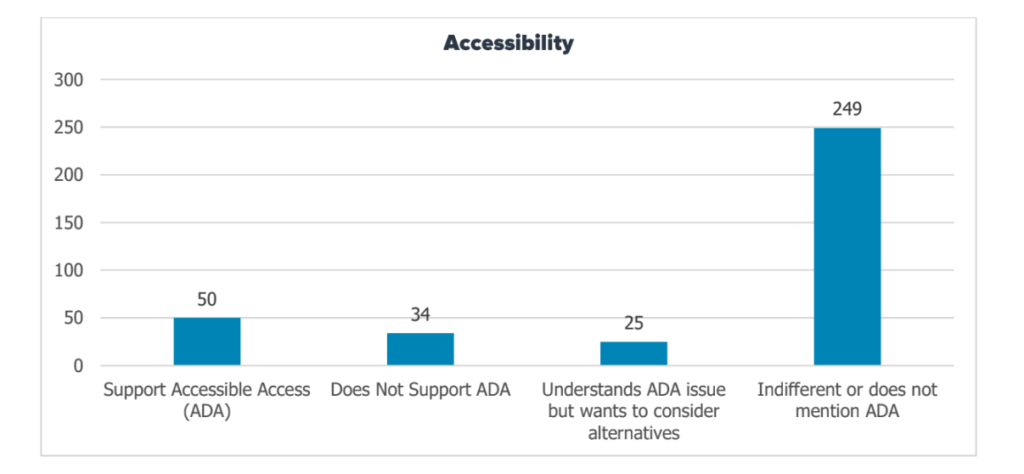
Neither the DNR nor the governor’s office announced that it had commissioned the RFPs. The public learned of the newest development only via the April 12 press release, which was issued the day after the April 11 deadline for firms to submit their proposals.
Sarah Hoye, DNR communications director, said the contract was still open, so they could not reveal the companies that had bid on the job. That information will be available in the future from the Department of Administration.
According to the timeline within the RFP, final design and construction dates were “to be determined.” Leading up to that, the company would be selected this month and the project kicked off in May, with the concept report completed in December 2022.
“I don’t think it’s a coincidence that it’s after the election,” said Rep. Joel Kitchens (R-Sturgeon Bay), whose efforts to get the tower repaired have been stonewalled by the DNR several times over the past couple of years, and who issued a statement answering Evers’.
“They’re not being genuine in any of their efforts. I see it as more of the same,” Kitchens said. “They’re just pretending to do something.”
Evers said in his press release that his action was needed because the legislature had failed to provide funding or direction. Sen. Andre Jacque (R-DePere) fired back that the administration was shifting blame for its failure to restore and preserve the tower.
“Money is not an issue,” Jacque said, who’s a member of the State Building Commission. “The current state budget, which the Governor signed last summer, includes over $200 million for maintenance projects for state facilities – not to mention all the federal ARPA money he is distributing throughout the state. The DNR could have submitted a request to the Building Commission at any time, but they have failed to do so.”
Kitchens drafted legislation earlier this year that asked for American Rescue Plan Act (ARPA) funds to repair the tower and while the bill had a hearing in November 2021, it was not presented for a vote.
Historical Preservation Priorities Questioned
The tower was closed for the season in December 2017 and officially closed in the spring of 2018 after routine inspections determined it to be unsafe for public access. Since then, three studies have been done on the tower: the first commissioned in 2018 by the DNR with the USDA’s Forest Products Lab in Madison; the second commissioned in 2019 by the SBHSF with Wood Research and Development; and the third commissioned in 2020 by the Department of Administration to review the previous reports and provide an assessment of the tower with possible options to address the safety concerns.
The state’s request for concept plans “is to provide the department a course for the revitalization of the tower,” according to the governor’s press release. But those in the know have noted the careful wording in the RFP that signals that historical preservation isn’t necessarily a DNR priority.

“The project does not involve federal funds or require federal permits to be completed and so is not subject to Section 106 of the National Historic Preservation Act,” the RFP advises the bidding companies. Yet the RFP goes on to say that “this requirement will need to be reconsidered if funding sources for the construction of the project change.”
Section 106 requires that if it’s “feasible” to save a historical structure, it must be saved. If the delaying tactics push the tower into a state “beyond repair, they have beat that word ‘feasible,’” Weber said.
So although Evers and Cole said they were “committed to progress on the Potawatomi Tower,” those who have been fighting to repair the structure see more intentional neglect, and, Allen said, they “urge Gov. Evers to direct the DNR to restore the tower immediately.”


